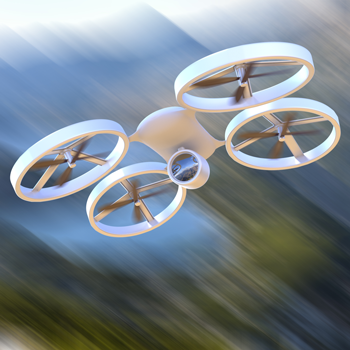It's about a year since we started the discussion on Drones.
You might’ve read our original article on the subject or our featured article in Athletic Business.
Since then, things have changed. There has been some drawbacks and progress – all at the same time.
For starters, more incidents have occurred where Unmanned Aircraft Systems (UAS) were involved.
The FAA has also started the conversation and process for creating rules that impact the use of UAS.
They’re even leading a public outreach campaign to promote the safe and responsible use of the aerial devices, inclusive of No Drone Zone signage to educate aircraft operators that flying in certain areas is prohibited.
Look:
The FAA is making efforts to put guidelines in place, but that hasn’t changed the security issues surrounding UAS as it relates to safety and security in public venues.
In this post, we’re going to review the benefits and the dangers of UAS, and what you can do to be ready for them.
Let’s dive in.
Positive Aspects of Drones
UAS can be used for creative and preventive means. We’re not refuting the fact that photographers and videographers can capture original, astonishing images and video of properties.
Aerial inspections are a great use of UAS. Flying a drone with a camera, for example, is often safer and much more cost effective than sending a person up (and up) to perform a visual inspection of your equipment.
The artistic factor pales in comparison to the value UAS can provide for event security, though. Think about the monitoring capabilities during events. They’re endless.
Coupled with your incident management process, UAS can play a major role in the identification and apprehension of associated persons involved in incidents.
One day, the benefits may become greater for operations. You might be able to use these aerial systems to counter external devices from entering your property. Or, they could help you locate and remove weapons - thwarting a dangerous incident.
The challenge of monitoring large groups of guests at your property or properties is greatly reduced. Using UAS, you can oversee engagement amongst guests and spot potential hazards before they occur.
The eye in the sky is real and yes, cool!
The focus here is prevention.
We get it:
We often discuss the complexities and importance surrounding mitigation of risk, as we want to work towards the prevention of all types of incidents.
We understand the obstacles faced by security to control every situation. We want to contribute to the success of security professionals the best we can.
Now:
We know you’re tasked with a very difficult role in the safety of guests and staff, especially with the increase of UAS-related incidents in the past 12 months.
Safety and Security Operations on High Alert
Look:
In order to be objective about the use of UAS, we didn’t want to provide you with a shortsighted view of the subject.
The benefits are there…
But, they pose a number of risks for your operation and the people you protect.
Let’s get some perspective on this:
Earlier this month a Drone slammed into the seating area at the U.S. Open. After flying above players Flavia Pennetta and Monica Niculescu, the device crashed into – thankfully – an empty seating area at Louis Armstrong Stadium.
It’s great that no one was injured, but can you imagine all the variables here? All the things that could have happened.
This is scary stuff.
With events similar to this being feasible to duplicate, we can imagine the looming incidents that’ll continue to evolve over time.
Unmanned aircraft systems present a boundless opportunity for criminals to negatively impact security efforts.
Consider this:
Drones are easy to transport and deploy, making them evasive. Operators can control these systems from a distance.
This poses a serious challenge for security professionals to apprehend suspects. By the time the device is located, the damage has already been done.
We’re back to Mitigation versus Prevention.
Mitigation helps, but the ultimate goal is prevention. You need to be proactive!
Now:
Supplement this with the capabilities of UAS. Low-flying aerial devices with elusive qualities, incidents are certain to occur quickly.
Take the U.S. Open incident and expand it and one can see the potential of an act of terrorism.
From arson, guns, bombs to spying, UAS give criminals an upper hand with the ever-changing, progressive technology available nowadays. It lets them be where they want to be…without being there.
Now:
What’s the difference between UAS that you control vs. external devices that are flown by private operators?
It’s logical to think that if you control the drone then you can get all the great benefits and mitigate the risk of outside UAS.
But:
What happens when someone infiltrates your device?
Hackers can take control over your drone causing great harm to your operation and the people you’re trying to protect. Even if you employ your own UAS to enhance security, you may create an added vulnerability.
So, proceed with caution.
The FAA Still Has Work to Do, They Need Your Help
UAS can be used to harass your guests, used to smuggle contraband into restricted areas at your property and illegally broadcast your televised events.
What are you doing to stop them? What measures have you taken to lower the risk associated with these systems?
Remember, the FAA doesn’t currently regulate them. There are no rulings for UAS to make preventing their effects a proactive process.
It’s unfortunate:
The law doesn’t give properties like yours an offensive for handling UAS – besides making it illegal.
Yes, the industry has made advancements in regards to locating these systems before they even leave the ground.
But:
Because it’s illegal to fly them over stadiums doesn’t mean you can shoot them out of the sky.
What do you do then?
Many methods for handling drone situations are illegal, but the FAA has started its Notice of Proposed Rulemaking (NPRM) for small, unmanned aircraft. It’s a step in the right direction, but very much in the early stages.
We strongly urge you to get involved in this conversation. It’s vital to increase the safety and security awareness associated with UAS usage. This is the only way to expedite the creation of countermeasures and full prevention of UAS-related incidents.
In the meantime, you can start using a solution to track these aircraft:
Solutions exist that can bring value to your incident management initiatives. These solutions detect ambient sounds specific to these aerial devices.
The solutions track the sounds against a database of signatures. Then, the solution will alert your emergency response teams, supervisors and command center via text or an email that a drone is approaching your perimeter.
It gets better:
Couple this with your incident management system and a drone detection solution can enhance your awareness. Your awareness is a vital part for ensuring security’s effectiveness – and your peace of mind.
Develop protocols to follow when your guests and staff encounter unauthorized UAS and put them in place for effective mitigation.
Right now, there’s not much to eradicate them but you can take the steps to lessen their impact at your property.
Get your copy of the FAA’s Law Enforcement Guidance for Suspected Unauthorized UAS Operations to understand the best measures to use when experiencing a UAS-related incident. We also recommend training your staff on information regarding unauthorized UAS operations at your property.
The ultimate goal is to identify the aerial device, prevent associated risks, locate the operator and take the appropriate legal measures. Do this to prevent any potential occurrences in the future.
It’s important to understand:
UAS carry a major security risk that will impact your operation.
With their existence, risk management and other operational costs become your responsibility. That’s why stopping them is crucial to your peace of mind.
Join the public outreach campaign today to have a safer property in the future.
Over to You
Have you encountered drones at your property? Does your incident management process for handling these devices prove effective?
Their presence continues to grow, and their effects on safety and security at properties do too.
So, will you join the effort for establishing fair and safe regulations for UAS usage in the United States?




